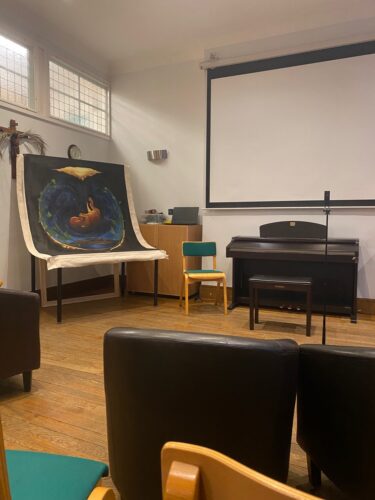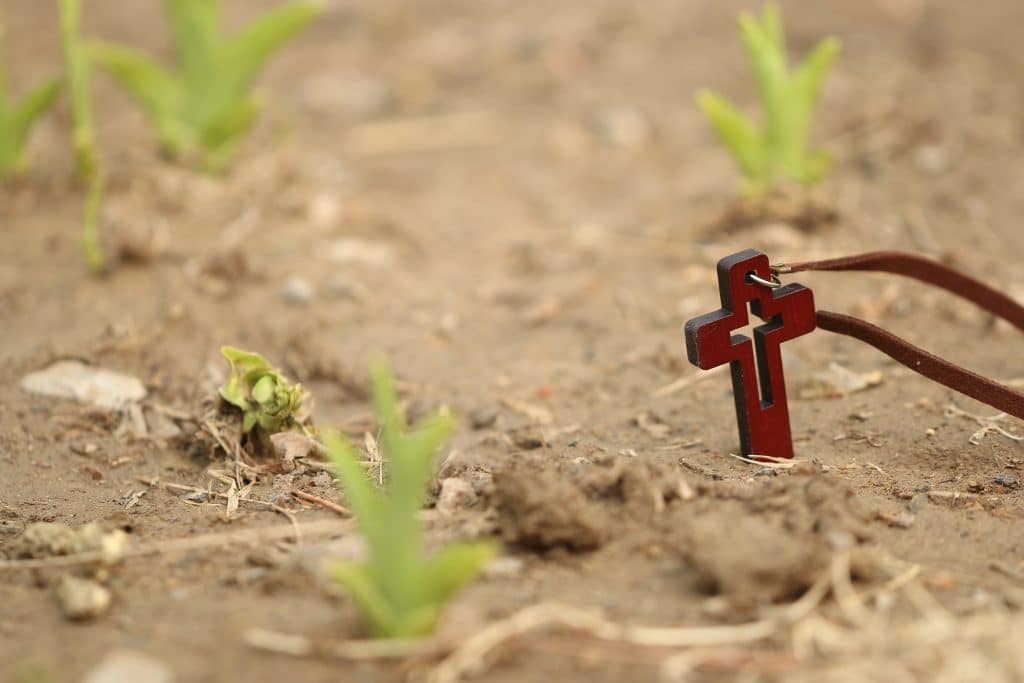Since attending September’s pro-life conference, I decided to go undercover again, this time with the Good Counsel Network – a Catholic pro-life organisation on London’s front lines protesting outside abortion centres. Groups like the Good Counsel Network were what first drew me to the pro-life movement in the UK. I wanted to meet the people you might meet if you sought an abortion in London. I think many of us have at some point wondered what those people are like. Who are they, what drives them, and how are they feeling?
After looking through their Facebook page, I found that the Good Counsel Network was hosting a lecture at Newman House, a Catholic student hub located in Bloomsbury. The lecture was quite literally titled “How I Ended Up Praying Outside an Abortion Centre and Why It’s a Good Thing to Do.”
Just before the lecture started at 6pm, I stepped off the busy street and into a building with a Pope Francis cut-out in the window, making sure every pedestrian knew exactly where I was going. The small lecture room felt familiar, reminding me of my old classrooms at Catholic school, with stained glass windows, crucifixes, and marble statues of Mary. I was struck by a large, large painting of a foetus in the womb in the room’s corner.

After I had settled in for a few minutes, our speaker nervously walked in: a young woman wearing a long skirt and a Good Counsel Network T-shirt. On her wrists, she wore not one but two rosaries, and in her left hand, she gripped the cross in her palm for the duration of the evening, like a fidget toy.
As the title of the lecture suggested, the first half focused on her personal journey, and the second half on why praying outside abortion clinics, in her view, a good thing to do. Her background was eerily similar to mine. She had also attended a Catholic primary school, which she said “wasn’t very Catholic,” before becoming what she called a “blasphemer” – showing photos of herself in various mock nun costumes, and a Mary-like look complete with a gold halo. I was the only one who laughed at the photos; I think I was meant to be appalled.
She then spoke about moving from her comfortable small town to London, to attend UCL’s art school. I couldn’t help smiling at our similarities. I, too, went to a Catholic primary school, which also made me a heretic of sorts. She described London as lonely and full of “darkness”. Whenever she felt the weight of this darkness, she would say Hail Mary prayers to soothe herself. She said she didn’t like where she was living. I imagine she felt lonely; university halls can be lonely spaces. From experience, I know they can be strange, isolating, and even toxic environments. She eventually decided to move into Newman House, a Catholic boarding house.
When she told her “liberal, pro-choice art school friends” where she was moving, they began to drift away one by one. The painting she brought with her marked the grand unveiling of her new identity, which she presented to her class while “showing them the rosary” and singing a hymn. A girl who had once been her friend couldn’t bear to watch and got up to leave.
I vividly pictured the scene in my mind, and can only imagine how uncomfortable it must have been. The speaker told us that her professor had said she couldn’t even look at the painting; she and the Good Counsel Network’s priest speculated that the professor’s reaction perhaps stemmed from guilt over a possible past abortion.
She went on to say that while she was living at Newman House, the priest in the corner had told her about a local abortion centre and suggested she might think about going over to help the women.
Then she moved on to why, in her view, praying outside abortion centres is a good thing to do. She spoke at length about how she cannot take credit for any of her work because, since devoting her life to the cause, she is purely a vessel for Mary, simply doing what the mother of God wants from her. She explained that she feels compelled not to sit idly by while innocent babies die on her doorstep.
She described the setup at the centres: they go in pairs so that one person can hand out leaflets while the other “leads the prayer.” She also made it clear that she prays out loud. When she tried to persuade the rest of us to go, she spoke about the pure sense of peace she feels standing just outside the buffer zone.
She said that when she first started, she was concerned that her presence might feel like an “invasion” to the women seeking an “intimate procedure” at a “very difficult and even traumatic time”. I smiled and nodded at her instinct, before she said she had cast it from her mind, because to her that was part of the old “pro-choice mindset” she had inherited from art school.
During her crisis of faith in her first few months in London, she described feeling despair at the thought that if there were no God, then there would be no hope or purpose. She said she sat with the feeling and really hoped it would be true, and once you reach that point, it’s only a small step before you start to believe it is. She joked that her conversion was “social suicide”. Now, she said, she is “on the other side,” adding, “Are you really Catholic if you aren’t dead to the world?”
As I sat in the church hall, I felt a little sad that her coping mechanism had cost her all her friends. I thought about how, if I had struggled with moving here in the same way she had, and if I had found a different passion, I might have been joining her on the street, handing out leaflets.
After hearing her speak, I wanted the chance to talk with her, to meet her peers, and see what they might say to a potential volunteer. Over email, I was told I could meet more representatives at Newman House’s volunteer fair. So, I returned the following week, hoping to see the speaker again. From the lecture, I had learned a lot about the journey to the buffer zone, but very little about what being there actually involves.

When I arrived at Newman House, the atmosphere contrasted sharply with the quieter, sparsely attended lecture the week before. The two rooms hosting the fair were lively and crowded. Even though it was midday, they were serving coffee and croissants, as most people had been at mass since ten o’clock. I moved around the room, chatting with representatives and collecting leaflets.
When I saw the speaker from the lecture standing alone, I approached her and opened by complimenting her lecture, before mentioning our shared experiences. She remained very soft-spoken, speaking as though she were apologising. When she started opening up, she said that what she had lost in community and friendship at art school, she had more than regained at Newman House and where she now lives, in the Good Counsel dormitories. It was hard not to believe her in such a lively, bustling room. As a returning face, I, too, received a very warm welcome back.
She hinted at something I wanted to know more about. When I asked how she found living at a pro-life centre and working for the cause every day, she said it was both easy and hard. She said that although it is hard to commit to showing up, it is ultimately a very easy thing to do. When I asked if she meant physically, she disagreed and said that sometimes she feels as though all she is doing is standing on the street saying prayers. After a pause, she seemed to contradict herself, saying that despite that, she does feel she is on the “front line of a spiritual war”. Her sudden conviction surprised me; it felt rehearsed.
It might have been her hesitant speech patterns, or the constant grip she kept on the rosary around her wrist, but I couldn’t help thinking she felt some level of conflict, not about the impact of her efforts, but about her role as a soldier in this “spiritual war”. I sensed she believed she was taking the easy route, that she could be doing more. This was a feeling shared by the other two interns there. I began the conversation by asking how they had got to where they were. Only one replied. It was her gap year, she said, “for experience”.
I wanted to know how they felt about the hardships they faced. They spoke about the abuse hurled at them by passers-by, and laughed when I compared it to a hit-and-run. The lecturer last week had said that she feels protected by a prayer shield from Mary when she is out there, but the two newer girls said they found it harder. I wouldn’t wish anonymous street abuse on anyone, but they implied that they saw it as a signal that they were fighting the good fight.
I asked what impact they felt their presence had. This was when they brought up the buffer zones. It is the most frequent talking point I have found at events like this: dissatisfaction with the government’s rules that set a 150-metre limit on their presence around abortion centres. These two had never worked before the buffer zones were introduced, but they said they had heard stories about the contact they used to be allowed. That is, of course, their goal: direct contact with women approaching the centres, which they make very clear.
I asked what they could see from their station, and they said they could not see the entrance or the exit. I replied, “I suppose that’s probably a blessing and a curse, because at least they do not feel the pain of seeing women leaving after the procedure.” They agreed in part but still wished they could be closer. They admitted that in the two months they had been stationed in the same spot every day, they had not spoken directly to a woman considering an abortion. I have to admit I was relieved, but they did not seem disheartened. They said people take leaflets every day, and even though they never see the impact they make, they feel it just as strongly.
I felt a much stronger connection with these girls than at the larger events. I do feel sympathy for them. I even liked them. They were very kind and friendly, and they seemed genuinely unwilling to impose themselves (partly because the buffer zone prevents them), and truly believed in what they were doing. They see themselves as standing up to what they believe is a murder clinic, their response limited to praying and handing out leaflets while being shouted at.
I cannot help but think about the restrictions placed on them and wonder what they might be like without those limitations, and what impact they still have on the women seeking medical care. They may no longer be an overtly invasive presence, but instead a distant one. I do not know what to believe about them. I want to think that they simply stand and pray, silently or quietly, and as they say, only exist if women need them. But if that were true for all of them, the law would never have intervened. They cannot all be telling the truth, though I believe these particular girls were.
They may be wholly committed to their cause and genuinely believe they are on the right side of history, but there is a sense of frustration among them. I do not doubt that they feel the impact of their work, yet I also sensed a lingering feeling that they could be doing more.
I do not feel comfortable drawing any comparison between abortion and a real genocide, but it is one that the first lecturer made, and I can see a similarity in how both groups of activists cry out and are ignored. The pro-life activists believe that mass murder of innocent lives is taking place in our own city and, if I truly felt that way, I would probably fight back too, and feel frustrated at being silenced or ignored by the law.
Perhaps my stance has softened since being around them and trying to empathise truly, but maybe that’s not a bad thing. I understand more clearly where they are coming from and why they act as they do. Although we live in very different worlds, and their beliefs conflict with mine, we share a concern for human life. We simply disagree on when it begins.
After observing the movement more closely, I see people who are both steadfast and disaffected, frustrated by their marginal status among other activists, yet convinced they are right. What I have learned is that, while our side may doubt whether we will succeed, they never doubt that their cause will eventually prevail. I hope they are wrong.



